Battleship Queen Elizabeth. Noble blood frozen in metal
In optics, the silhouette of the battle cruiser Von der Tann, bursts of volleys and torpedo breakers refracted. Battle debut off the coast of Jutland!
A quarter of a century is just a moment. The cliffs of Narvik, snow charges and flying debris of destroyers swept through the sight. Change of course - Mediterranean. Giulio Cesare is on the horizon. Volleys from extreme distances, unexpected success. The enemy retreats, leaving a plume of smoke astern.
The roar of guns shakes the coast, heavy shells fall on naval bases in Libya and Albania.
Radar contact in pitch darkness. The ship firing point-blank, tearing apart the Zara, Pola and Fiume with its main caliber.
The rays of the setting sun and stones from the Neolithic era. The last defenders of Crete. The rumble of dive bombers, antiaircraft guns. Bombs hit the deck. The new course is to the east, through the Suez Canal.
An island lost in the vast ocean. Military base or luxury yacht club? Pearl Harbor is home to jazz and a peaceful life.
Washington State Shipyard, foreign American accent. The damage has been repaired and it is not possible to return to the previous route. Japan has declared war.
The ship heads south to the beaches of Sydney, Australia. And again - the vast expanse of the Pacific and Indian oceans. The pursuit of the Japanese compound. On the lag - 160 thousand miles traveled, on the calendar - the winter of 1942, on the flagpole - "White Ensign". Royal Navy flag.
The scent of exotic spices from Ceylon and the yellow dust of the Suez Canal. Under the shots of 15-inch guns, the coast of Italy shudders. 1943, fire support for the Avalanche and Husky landing operations. Black crosses are flying in the sky, guided bombs are rushing to the ship.
Explosions and 5 tons of received water. But this is a British ship, sir. Stay in place and fight for damage. Evacuation plan: Malta - Gibraltar - Rosyth.
Sleepy morning in Normandy. Ancient guns were the first to alert the coast of the beginning of the invasion of Europe. Large-caliber land mines have plowed a section of the Svord beach.
The battleship continued to fire throughout the summer and fall of 1944, being blown up by mines and gradually moving north along the coast. His last combat mission was the shelling of targets in the Netherlands.
At this point, you should take a breath and find the right words about one of the most active ships in stories... A participant in both world wars, who went through an insane number of twists and turns.
To your attention: the battleship "Worspite" (Warspite, anger of war). One of five representatives of the Queen Elizabeth type.
Knights and aristocrats
Direct descendants in the male line of the famous "Dreadnought". With such a pedigree, every path and opportunity opened up for them.
The Queens are the oldest British battleships that took part in World War II. Designed at the beginning of the century, when boilers were fired with coal and oil was considered exotic. Two decades later, they were still considered a worthy contender.
There were reasons for that.
The offspring of noble blood had little in common with their peers from "dysfunctional families."
There will be a tough example. For interest, take a look at our "Baltic long-term construction". Supporters of the greatness of tsarist Russia will shyly look away. Meanwhile, "Queen Elizabeth" and "Sevastopol" entered service in one year (1914).
Critics and sympathizers will probably argue that "Queen" has done the same for everyone. Ostfriesland, Kaiser and the Italian Andrea Doria. All are outdated in an instant. In general, everything was normal. Until that Englishman was ahead of his time.
The Queen's level was partially "taken" only in the Bayern project. But the Germans paid for a similar main caliber with half the power of the power plant.
The Bayern series consisted of two built units. Further, during the period under review, no one attempted to build high-speed battleships with the main caliber of 381 mm. Naval commanders and engineers came up to discussing such issues only at the end of the war. And the overall balance of characteristics achieved in the Queen Elizabeth project remained the "top bar" for the entire class of battleships for a long time.
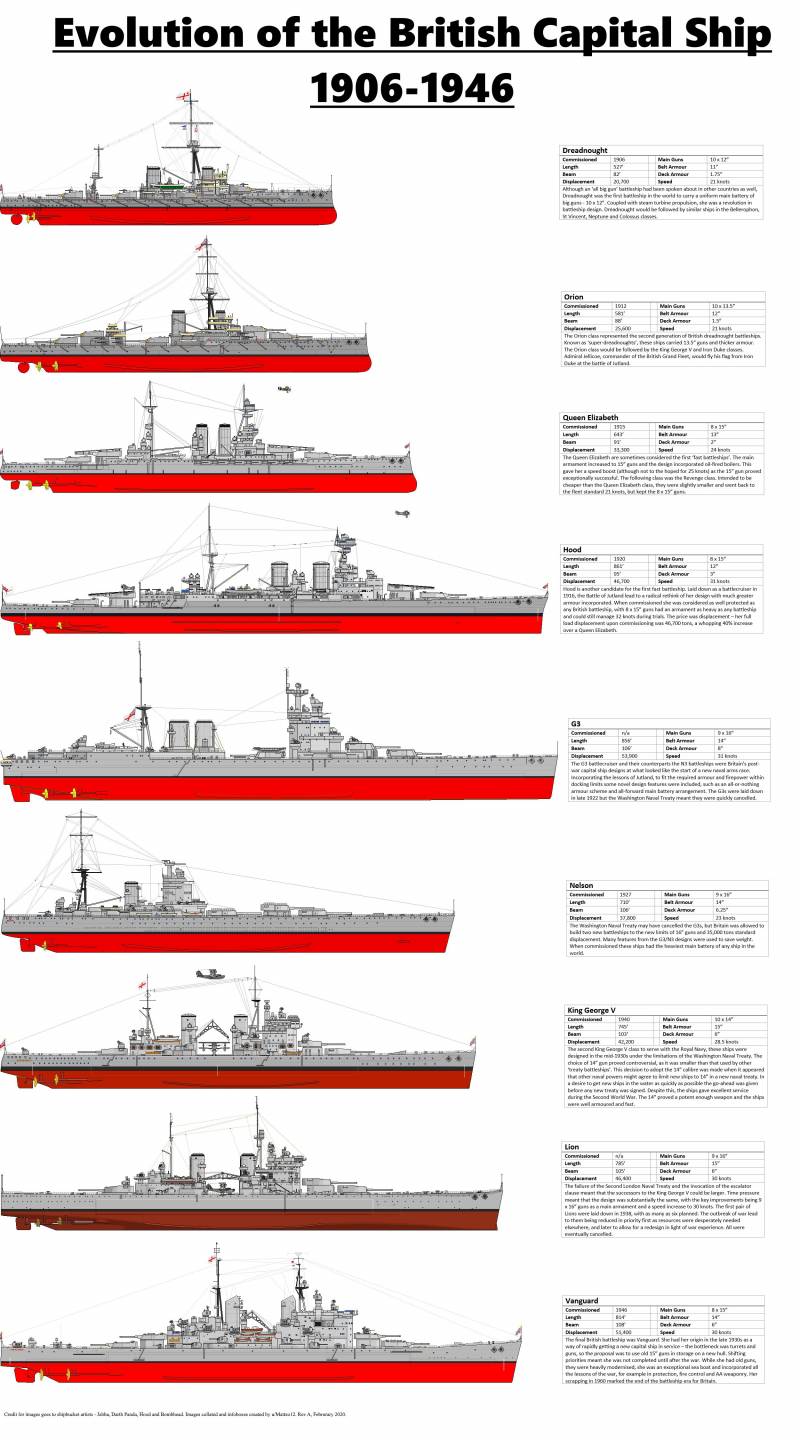
Comparison of the appearance and size of British battleships - from the "Dreadnought" to the late "Vanguard", which entered service after the end of the Second World War.
Further successes were facilitated by the era of international restrictions.
The value of the main caliber of European fleets forever stood at 15 inches. With the British himself fleet an amazing story happened. For two decades, Queen Elizabeth has retained a number of significant advantages over battleships of all new types!
The following LCs of the "Rivenge" type were planned to be made a "budget" version of the "Queens". Parity was achieved in terms of firepower, at the cost of simplifying the design and reducing speed.
Built during the interwar period, Nelson (1927) fell victim to contractual restrictions. The superiority in fighting qualities was not so obvious. "Queen" was not only faster than the new battleships, but could, for example, boast of the presence of protected extremities.
The fast-moving King George V (1939) had a congenital artillery defect. Uncertainty about international restrictions and a rush in anticipation of a "big war" led to the choice of the 14-inch main battery. That subsequently more than once or twice became the object of criticism.
Throwing with a choice of caliber had a known result. The last and most advanced in its class, the Vanguard (1946), was armed with 15-inch cannons. The ones that were created at the beginning of the century for the Queen Elizabeth project ...
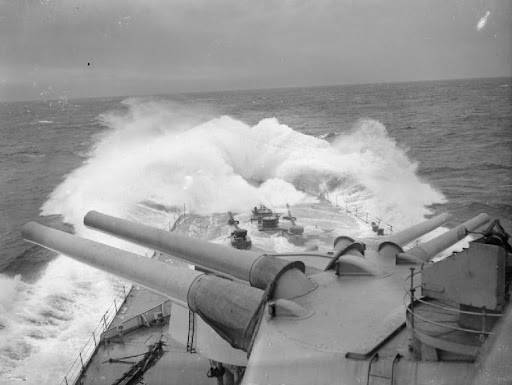
The British 15-inch "Mark I" is considered one of the most successful large-caliber naval guns. Expectedly powerful and balanced in all the parameters that characterize such weapons.
From these cannons, the British navy smashed opponents of different eras. From the High Seas Fleet to the Kriegsmarine ships with the black swastika. Hit the walls of Turkish forts (1915) and Japanese fortifications in the Andaman Islands (1945).
In addition to the Queens, five series of battlecruisers and battleships were armed with such weapons. And each combat episode showed the following.
15 “retained importance in both world wars
In 1941, the German "Scharnhort" and "Gneisenau" refused to approach the convoy SL-67, in the cover of which the battleship "Malaya" was seen.
The two of them ran away from the battle cruiser "Repals", getting a 15-inch "blank" on the forehead. And they did not dare to approach "Ramilles". Perhaps the most "unconvincing" of the Mark I gun carriers. An outdated and not modernized battleship of the Rivenge class.
The Germans had no confidence in the imminent reprisal of these antiques. And the protracted firefight with the participation of 381-mm cannons threatened the Scharnhorst-type LK (LKR) with unpredictable and painful consequences.
The Mark I impressed even the most protected ships in history! Weaker opponents, this cannon, firing 880-kg shells, could "take out" with one hit.
In the battle at Cape Stilo, a shell fired by Worspite tore the Cesare citadel. Critical elements (ammunition, MO) were unaffected, but the destruction, debris and fires were enough for the Italian battleship to immediately slow down and withdraw from the battle. Losses in killed and wounded amounted to more than 100 people!
This incident, known as the "Calabria Shot", set a record for naval battles.
(Admiral Cunningham)
Hitting a moving ship from 24 kilometers was an accident. But the effect of hitting an 880-kg projectile was quite expected.
The 15-inch caliber turned the Queens into the most powerful ships of the First World War. And only thanks to him, the "Queens" retained their importance during the Second World War.
Eight 381 guns fired a heavier side salvo than ten 343-mm guns from the battleships Iron Duke, King George V or Orion. In numbers: 6 kg versus 804 kg.
This circumstance made it possible to abandon the fifth main-caliber turret in the middle of the hull. The place of which was taken by the mechanisms of the power plant.
The battleship formation "Queen Elizabeth" was intended to become the "fast wing" of the line fleet, operating in one formation with the battle cruisers.
The power of the power plants at the peak exceeded 70 thousand liters. with., and the speed reached 24 knots.
The Queens' technical records left the admirals in a bad mood. To fully comply with the plan, even higher indicators were required, which were impossible for that time. Such values were achieved much later, in the 1930s – 1940s. When the line between the concepts of "battle cruiser" and "battleship" was erased.
The speed did play a role. The Queens were assigned to one formation with the battlecruisers. And they were able to provide belated support to the LKR in the Battle of Jutland.
Possessing superiority in protection, the German fleet managed to inflict significant losses on the British. Victory was approaching with a "dry" score, but then next to the "Panzerkrucers" pillars of water shot up, one and a half times higher in height than the splashes from the falls of 343-mm shells.
Nice acquaintance
The illustration shows the result of a 381-mm projectile hitting the battle cruiser Von der Tann from the battleship Valiant. The shell pierced the 100-mm belt at the tip like foil and exploded inside, damaging the steering gear. The uncontrollable German "rolled out" in front of the approaching armada of British battleships, risking repeating the fate of the "Blucher" on the Dogger Bank. However, the emergency party managed to regain control. Another consequence of the hit was a torn off plate of the underwater belt. About 600 tons of water entered the hull, which led to a roll.
The British were too long in the euphoria of ships with 381-mm main caliber. In the 1920s, having lost the ability to lay down new battleships, they discovered that the core of the fleet was still the Kuins from the early 1910s.
In fact, the situation was not critical. The potential of "Queen Elizabeth" was enough for a long time. With timely modernization, battleships of this type fully met the requirements of the era and could even surpass competitors in some way. The power plant was changed, boules, anti-aircraft guns and modern fire control devices appeared. By 1941, the head Queen was equipped with three radars and a friend or foe radio system.
This caring attitude had its results. Unlike many younger ships, the Kings and Queens met news about the beginning of the war fully armed and full combat readiness.
Queen Elizabeth and Worspight served to the very end as ships of the line. Barham died in 1941. Malaya was damaged and was transferred to the category of training units in 1943. The Valiant lasted longer, interrupted by a non-combat incident.
The greatest fame was acquired, of course, "Worspite". Even one such fighter justified the existence of an entire Queen Elizabeth series.
In fact, each of the representatives of the series honestly fulfilled the assigned tasks. Inspired and limited the actions of the enemy in the theater of operations. Bravely endured battle wounds and snapped back fire. He covered convoys and took part in the battles of the line forces. First, in the waters of the mother country and in the Mediterranean Sea, where the Italian fleet was considered the main enemy. And in fact - saboteurs of the "black prince" Borghese and aircraft of the Luftwaffe.
The lead "Queen" and "Valiant" managed to take part in hostilities in the Pacific and Indian oceans. The last parade for Valiant came when it was being repaired. The floating dock, falling apart, almost dragged the battleship to the bottom.
Steampunk Epilogue
Time did not spare the once strongest ships. The former favorites were gradually losing their dominance. It was increasingly difficult for them to recover from their wounds, and the technical appearance had long ceased to correspond to the times.
"Queens" would not have enough speed to play the role of "boss" in the aircraft carrier groupings. Their vertical protection could still match the standards of WWII battleships, but the thickness of the armored decks left much to be desired. As the death of Barham showed, the design of the 1910s could not effectively withstand the effects of torpedo weapons... Partly because of the small size of the battleships themselves.
The Queens had no idea about the universal medium caliber. And the total electrical power of the turbo and diesel generators was almost 7 times lower than that of the American Iowas.
They continued to be considered tier 1 units due to their unique weaponry. But the saturation of the fleet with new battleships of the "King George V" class eliminated the need to continue the exploitation of veterans. In the event of damage, they tried to withdraw to the reserve. The naval enemy himself disappeared. The last of the active battleships of the Kriegsmarine was sunk in December 1943 (Scharnhorst).
All ships of this type, except for the deceased battleship Barham, were immediately scrapped after the war. But Worspight finished the most enchanting of all.
The Worspite was dying laughing at the gloom of the cutting docks. In 1947, while being towed, it ran aground and so tightly grabbed the underwater rocks that it was impossible to move it. The battleship began to be disassembled right in the water. The last remains of Worspite disappeared from view under the blows of storms and waves in 1955.
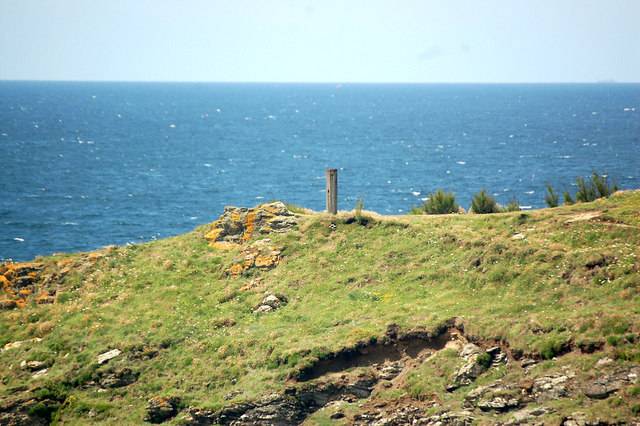
Rest at the bottom, unconquered knight
The history of the battleships Queen Elizabeth contains a lot of impressive information. But one point is interesting. In our time, it has become customary to see huge frigates armed with a water cannon and a machine gun. And the designers cannot allocate space for an extra ten missiles.
How 110 years ago it was possible to "stuff" 4 tons of weapons and 500 tons of armor, a crew of 8 people. and a steam turbine plant, which developed a capacity of half of the nuclear "Orlan", in a hull with a standard displacement of 750 thousand tons?
What capabilities would a modern missile cruiser acquire while maintaining the hull and security level of Queen Elizabeth?
I invite readers to leave their comments.
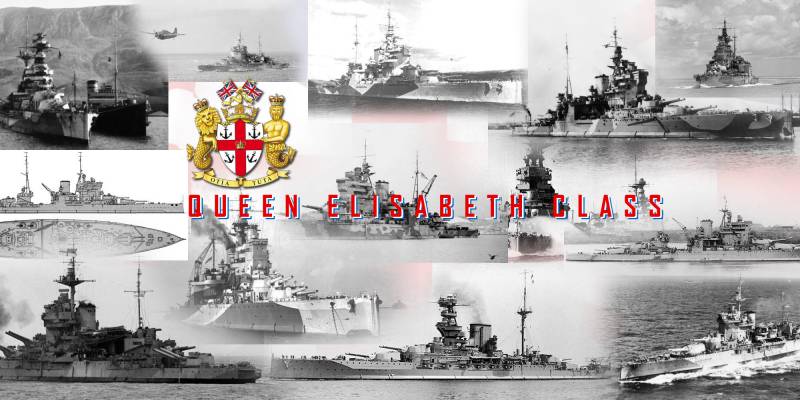
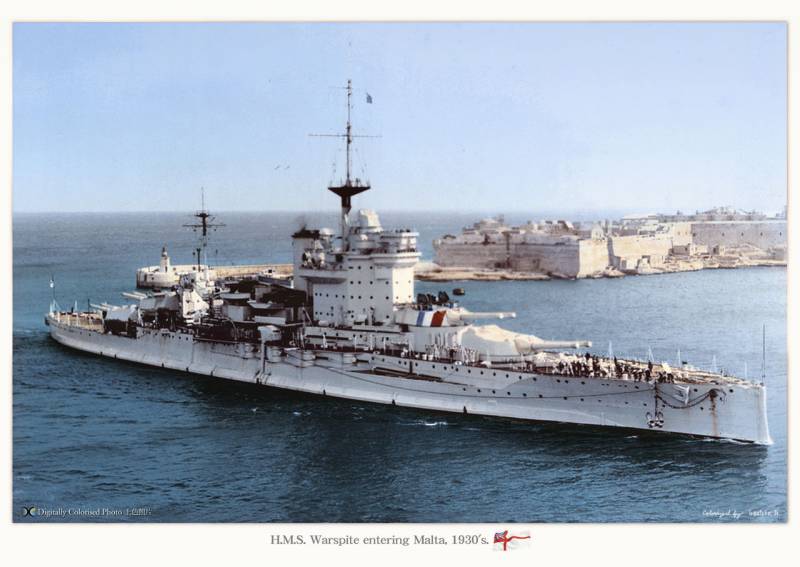
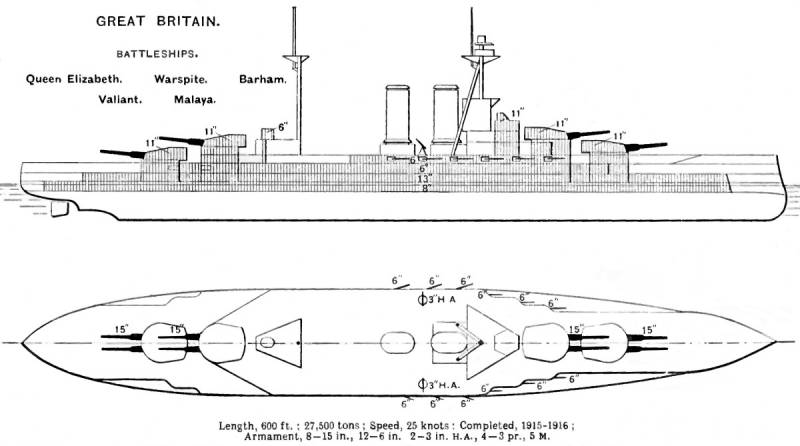
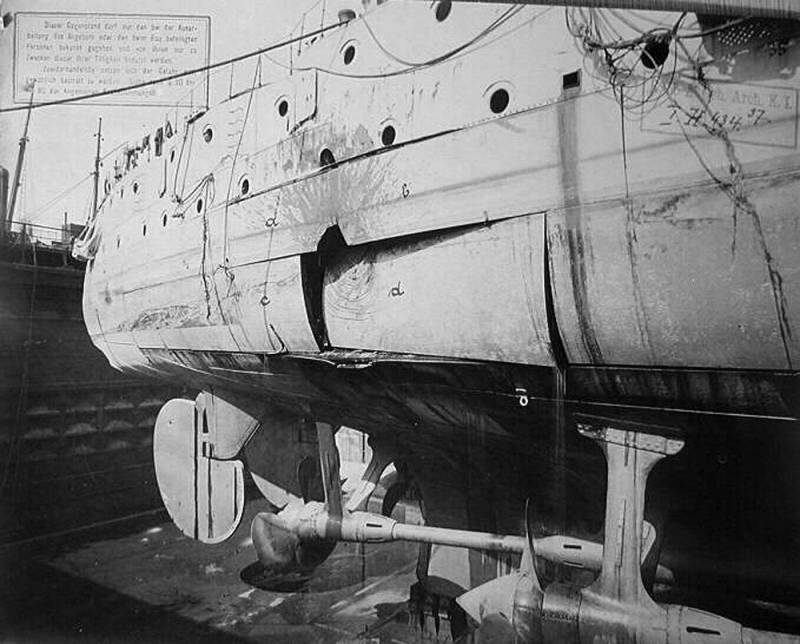
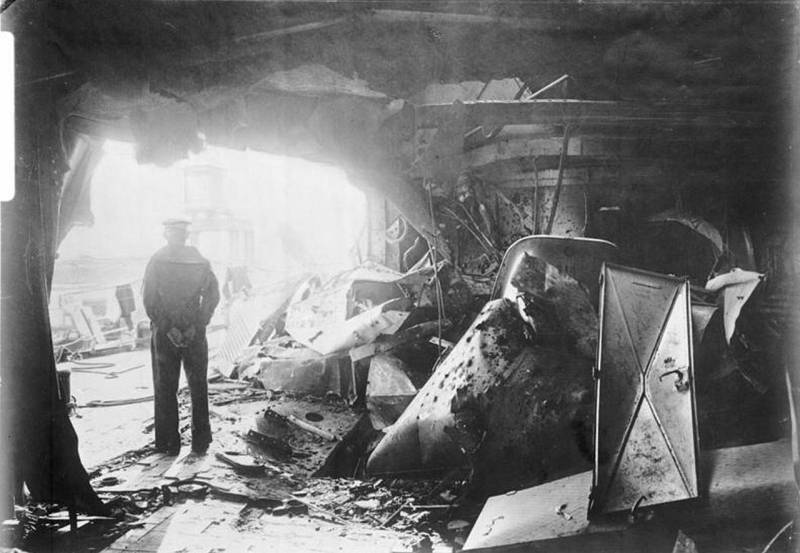
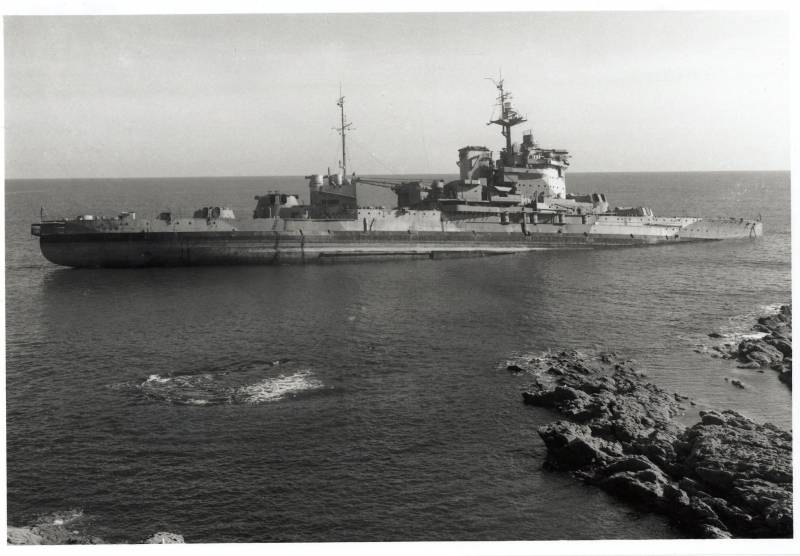
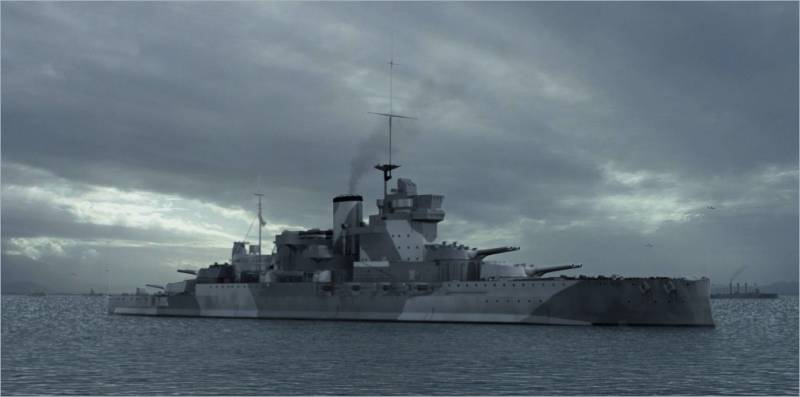
Information